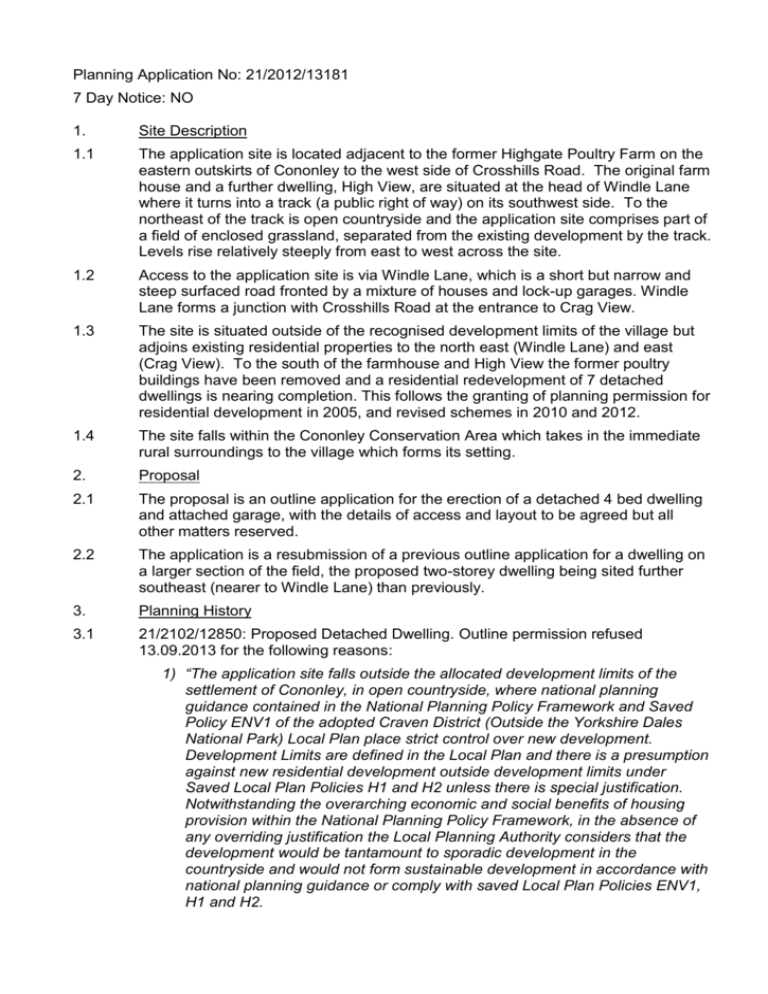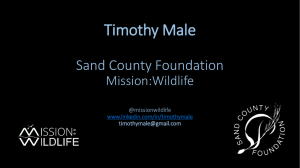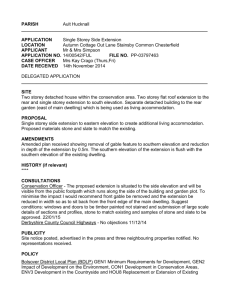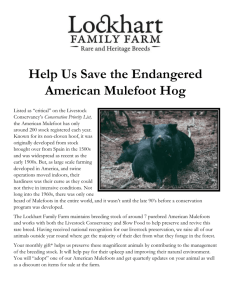Planning Application No: - Craven District Council Online Planning
advertisement

Planning Application No: 21/2012/13181 7 Day Notice: NO 1. Site Description 1.1 The application site is located adjacent to the former Highgate Poultry Farm on the eastern outskirts of Cononley to the west side of Crosshills Road. The original farm house and a further dwelling, High View, are situated at the head of Windle Lane where it turns into a track (a public right of way) on its southwest side. To the northeast of the track is open countryside and the application site comprises part of a field of enclosed grassland, separated from the existing development by the track. Levels rise relatively steeply from east to west across the site. 1.2 Access to the application site is via Windle Lane, which is a short but narrow and steep surfaced road fronted by a mixture of houses and lock-up garages. Windle Lane forms a junction with Crosshills Road at the entrance to Crag View. 1.3 The site is situated outside of the recognised development limits of the village but adjoins existing residential properties to the north east (Windle Lane) and east (Crag View). To the south of the farmhouse and High View the former poultry buildings have been removed and a residential redevelopment of 7 detached dwellings is nearing completion. This follows the granting of planning permission for residential development in 2005, and revised schemes in 2010 and 2012. 1.4 The site falls within the Cononley Conservation Area which takes in the immediate rural surroundings to the village which forms its setting. 2. Proposal 2.1 The proposal is an outline application for the erection of a detached 4 bed dwelling and attached garage, with the details of access and layout to be agreed but all other matters reserved. 2.2 The application is a resubmission of a previous outline application for a dwelling on a larger section of the field, the proposed two-storey dwelling being sited further southeast (nearer to Windle Lane) than previously. 3. Planning History 3.1 21/2102/12850: Proposed Detached Dwelling. Outline permission refused 13.09.2013 for the following reasons: 1) “The application site falls outside the allocated development limits of the settlement of Cononley, in open countryside, where national planning guidance contained in the National Planning Policy Framework and Saved Policy ENV1 of the adopted Craven District (Outside the Yorkshire Dales National Park) Local Plan place strict control over new development. Development Limits are defined in the Local Plan and there is a presumption against new residential development outside development limits under Saved Local Plan Policies H1 and H2 unless there is special justification. Notwithstanding the overarching economic and social benefits of housing provision within the National Planning Policy Framework, in the absence of any overriding justification the Local Planning Authority considers that the development would be tantamount to sporadic development in the countryside and would not form sustainable development in accordance with national planning guidance or comply with saved Local Plan Policies ENV1, H1 and H2. 2) This previously undeveloped land forms part of the landscape setting of Cononley village and falls within the designated boundary of the Cononley Conservation Area. Having regard to the existing use of the site as pasture and the separation between the redeveloped former Highgate Poultry Farm and existing residential development, it is considered that the encroachment of development into open countryside as proposed would fail to preserve or enhance the conservation area. As such the application proposals would not accord with the Section 72 of the Planning (Listed Buildings & Conservation Areas) Act 1990, or form sustainable development under National Planning Policy Framework guidance.” 3.2 There is no earlier history relating to the application site, although the adjacent Poultry Farm site has a history of residential applications: - 3.3 21/2003/3779: Demolition of agricultural buildings and erection of six dwellings and garages and restoration of western part of site. Approved October 2005. 3.4 21/2009/9955: Erection of six detached dwellings with garages and access road and restoration to South Western part of site to agriculture. Approved 30 March 2010. 3.5 21/2010/11198: Construction of detached house and garage. Refused 12 January 2011. 3.6 21/2012/12296: Construction of detached house and garage. Approved 10 April 2012. 4. Planning Policy Background 4.1 National Planning Policy Framework (NPPF). 4.2 Saved Local Plan policies ENV1, ENV2, H1 and H2. 5. Parish/Town Council Comments 5.1 Cononley PC: No comments received. 6. Consultations 6.1 NYCC Highways: No objections, recommend approval subject to conditions regarding parking provision. 6.2 Ramblers Association: “No objection to it as long as the right of way is maintained through the building period.” (Officer note: No obstruction of the public right of way is indicated and the highway authority have no objections). 7. Representations 7.1 None. 8. Summary of Principal Planning Issues 8.1 The principle of residential development at this location (having regard to the National Planning Policy Framework and saved local plan policies). 8.2 The impact of the proposal on the character and appearance of the Conservation Area. 8.3 The impact of the development on the amenities of nearby residents. 9. Analysis 1. The principle of development 9.1 The main thrust of the new National Framework is an overarching presumption in favour of sustainable development; i.e. the general acceptability of the proposals against the stated “three dimensions to sustainable development, which according to the Framework has three broad roles: “economic, social and environmental”. The guidance advises that these roles should not be undertaken in isolation because they are mutually dependent; i.e. the guidance states economic, social and environmental gains should be sought jointly and simultaneously. The Framework also reaffirms that it is the Government’s clear expectation that local planning authorities should deal promptly and favourably with applications that comply with up to date plans and that where plans are out of date, there will be a strong presumption in favour of sustainable development that accords with national planning policies. 9.2 Paragraph 14 indicates that development should be approved unless any adverse impacts of doing so would significantly and demonstrably outweigh the benefits, when assessed against the policies in the Framework taken as a whole, or specific policies in the Framework indicate development should be restricted. However, it is a core planning principle in the Framework that the “intrinsic character and beauty of the countryside” be recognised; that planning should contribute to “conserving and enhancing the natural environment” and “conserve heritage assets in a manner appropriate to their significance” (Para 17). 9.1 Development Limits for settlements are defined in the adopted Local Plan and, to avoid sporadic development in the countryside, there is a presumption against new residential development outside development limits under Saved Local Plan Policies ENV1 and ENV2. Saved Policies H1 and H2 seek, in general terms, to locate the majority of new residential development in the existing main service centre settlements. 9.2 In this case the site is located on the edge of the existing built up area, alongside a former poultry farm recently redeveloped for housing, but falls outside the development limits of Cononley; hence for planning purposes falls within open countryside. 9.3 In the Planning Committee’s consideration of the 2005 and 2010 applications for the redevelopment of the poultry farm buildings it was concluded that notwithstanding the location outside development limits, the site should be released for residential development; because of the benefits and improvement to the character and setting of the Conservation Area that would result from the removal of the degraded agricultural buildings. It was assessed that the proposed dwellings on the footprint of the poultry sheds would not compromise the overall provisions, aims and objectives of the adopted local plan and there was no strategic objection. (A separate S.106 Agreement was entered into to reclaim the other surrounding land for agricultural use thereby securing the restoration of the open land to the south west of the development). 9.4 In contrast, the area of land which forms the current application site is pasture land outside of the area previously occupied by the poultry buildings, and does not form part of the area considered for redevelopment in the 2005 and 2010 planning applications. In particular, the application site lies beyond the track, a public right of way, which presently forms a clear edge to the built up area. Therefore, it follows that there is not the same justification for development outside of recognised development limits as there was on the site of the poultry farm buildings and in terms of the principle of residential development, the current proposal is tantamount to sporadic development in the countryside. The proposal would not, therefore, constitute sustainable development in accordance with the Framework and would be contrary to saved Local Plan Policy ENV1. 9.5 The applicant argues, within the resubmission, that the absence of a 5 year land supply in the district justifies (under Para 47 of the Framework) approval of an additional house, however, it is the officer opinion that a single dwelling provides no strategic benefit that outweighs the individual harm caused by the development. 2. Conservation Area Impact 9.6 Section 72 of the Planning (Listed Buildings & Conservation Areas) Act 1990 requires planning authorities “to pay special attention to the desirability of preserving or enhancing the character or appearance of that area” in considering whether to grant planning permission or not. The NPPF sets out guidance on assessing the impact of development on heritage assets including listed buildings and conservation areas. The historic environment is seen as having potential to contribute to sustainable communities, including economic vitality; and it is therefore desirable that new development make a positive contribution to the historic environment and local distinctiveness (Para’s 126 and 131). In terms of general design (Para 64) confirms permission should be refused for development of poor design. 9.7 As an outline application the indicative proposal lacks full details about scale, character, and materials to assess the full impact on character and appearance. However, In terms of siting of the proposed dwelling, and the layout of the associated parking and gardens, it would appear the design would follow a similar form as the recently constructed detached houses on the poultry farm site to the south. These are modern in appearance and layout but reflect the local vernacular in materials and design features. In close proximity to east and north are somewhat older properties of more ‘suburban’ appearance, and beyond those (nearer the centre of the village) are traditional terraced cottages. 9.8 The ‘Heritage Statement’ accompanying the application refers to the relationship of the site to the built up area but fails to address the wider rural character setting of the village that is the subject of the wide boundary designation. As noted above, the more recent housing development further to the south was a direct trade-off for the former poultry farm buildings, and was allowed to enable the restoration of surrounding farm land so as to improve the landscape setting of the village conservation area. In this case the site is undeveloped farmland which lies outside the area covered by the former structures; consequently no such landscape benefit is achieved in this application. 9.9 The amendments made within the resubmission are firstly to reduce the curtilage to the house (and hence the site area), and secondly; to bring the dwelling closer to existing properties. However, despite these changes, it is not considered that the additional dwelling and encroachment into the landscape setting of the village would serve to enhance or preserve the character or appearance of the wider conservation area, as required by S.72. The applicant’s view that a small development on the edge of the built up area is not intrusive is not considered to overcome the concern about the encroachment into the landscape as it is an argument that could be repeated over and over again. 3. Neighbour Amenity. 9.10 Having regard to the orientation and separation to existing nearby properties, and the ability to control the position of window openings, it is not held that the proposed dwelling would have an unreasonable effect on the living conditions of the occupiers of any existing nearby dwelling by reason of any unacceptable overlooking, or dominant overbearing impact. 4. Public footpath 9.11 The proposal would not obstruct the public right of way and, further to the comment from the Ramblers Association, any obstruction during construction could be dealt with under highway authority powers. 10. Recommendation 10.1 Refusal. 11. Reasons for refusal 11.1 The application site falls outside the allocated development limits of the settlement of Cononley, in open countryside, where national planning guidance contained in the National Planning Policy Framework and Saved Policy ENV1 of the adopted Craven District (Outside the Yorkshire Dales National Park) Local Plan place strict control over new development. Development Limits are defined in the adopted Local Plan and there is a presumption against new residential development outside development limits under Saved Local Plan Policies H1 and H2 unless there is special justification. Notwithstanding the overarching economic and social benefits of housing provision within the National Planning Policy Framework, in the absence of any overriding justification the Local Planning Authority considers that the development would be tantamount to sporadic development in the countryside and would not form sustainable development in accordance with national planning guidance or comply with saved Local Plan Policies ENV1, H1 and H2. 11.2 This previously undeveloped land forms part of the landscape setting of Cononley village and falls within the designated boundary of the Cononley Conservation Area. Having regard to the existing use of the site as pasture and the separation between the redeveloped former Highgate Poultry Farm and existing residential development, it is considered that the encroachment of development into open countryside as proposed would fail to preserve or enhance the conservation area. As such the application proposals would not accord with the Section 72 of the Planning (Listed Buildings & Conservation Areas) Act 1990, or form sustainable development under National Planning Policy Framework guidance. Statement of Positive Engagement: In dealing with this application Craven District Council has sought to approach the decision making process in a positive way, in accordance with the requirements of paragraphs 186 and 187 of the NPPF. In this particular case the Council has provided reasons why a previous application was refused, however, no preapplication advice was sought and the application cannot be supported in principle.








